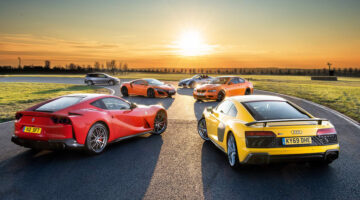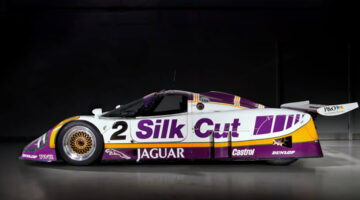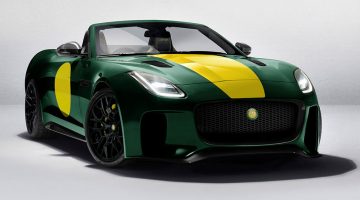We quiz Jaguar Land Rover Special Vehicle Operations ( SVO ) boss John Edwards on the significance of Project 7, the three-sided ‘triangle’ approach, and why Mercedes-AMG is a realistic target
—
“So, when’s the next Project 7 coming out?”
Admittedly there are plenty of topics we could discuss with Jaguar Special Vehicle Operations boss John Edwards. The opulent Range Rover SVAutobiography and the fiery Jaguar F-TYPE SVR represent two-thirds of the SVO ‘triangle’, with speculation mounting – but no official words forthcoming – concerning the first bespoke SVX off-road model. There’s also SVO’s brand new technical headquarters in the UK, into which Jaguar Land Rover has already invested $2.5 million. And that’s before we even dive into the lightweight E-Type and ‘lost’ XKSS limited edition projects, halo models of SVO’s new classic car business that sold out within weeks of their announcement.
I can’t help myself though. Project 7 was never originally destined for a production run, until the concept’s dynamic debut at the 2013 Goodwood Festival of Speed. Those 120 seconds effectively put Special Vehicle Operations on the map.
“Project 7 was very rewarding for us, absolutely,” a be-suited John, complete with Jaguar pin, explains to crankandpiston.com. “It originally started as a doodle, a cross between a D-Type and an E-Type, and was only intended to get some coverage for the F-TYPE during its launch phase. It was never going to go into production. Then we got 50 orders for the car the day Project 7 went public at Goodwood, and we naively thought, ‘should we do it?’
“We definitely could have built more than 250 – probably double that – but having a product that goes up in value the minute it leaves the showroom is rare. Plus, there were a lot of doubting Thomases at the beginning – originally we were only going to do 60 – because niche products are a distraction. Then again, look at the Evoque in 2011. Nobody thought we could sell that…”
Safe to say that the risk paid off, and while it would be another two years before all 250 models were built to completion, the ripple effect from Project 7 was enormous. Suddenly the pressure was both relaxed and tightened simultaneously (“we have our CEO saying, ‘you have to do more and faster, and really sweat that asset’ ”). Much like the ‘lifestyle’ Evoque, expectations for the more dynamic Range Rover Sport SVR – SVO’s first bespoke production model – underestimated the products potential: 3000 sales last year were triple what was expected.
—
More significantly though, the envelope was pushed on the F-TYPE R, a model SVO engineers genuinely believed was the sportiest they could create. Suspension tweaking, drivetrain remapping and revised aerodynamics saw the F-TYPE SVR nose its way over the hallowed 200mph (320kph) benchmark, aligning it with performance bigwigs Porsche, Aston Martin and even McLaren. Not that it came easily of course.
“In many ways the F-TYPE SVR has been our hardest challenge,” John continues. “The F-TYPE R is a pretty smoky car, so to take it above 200mph safely, that was a real challenge for our engineers, and we’re very proud of it. Above that? We don’t have any plans at the moment for a track-orientated F-TYPE, but never say never.”
There’s another three-lettered elephant in the room neither of us has mentioned yet. Demonstrating and promoting the performance capabilities of Jaguar’s halo sports car is one thing, but if SVO is to become a standalone sub-division in its own right, the AMG benchmark is stratospheric.
“I definitely think we can match them. Of course, you have to remember that we’re two and a half years old, whereas AMG has 50 years of history, so it will not happen overnight. But to be honest, I think we’ve come a huge way in two and a half years, and have established a platform from which we can really kick on. Over the next four years, we’re going to be introducing a new halo model every year, and yes, they’re part of our ultimate goal.”
—
Bear in mind though that the SVR weapons represent just one third of SVO’s business plan, and while the AMG GT R-rivalling F-TYPE SVR is busy extolling the performance capabilities of Jaguar, products like the SVAutobiography are busy raising Range Rover’s new ‘luxury’ perception to headier heights. Given that two such widely differing business models require significant investment and unwavering creative direction, how can SVO – only two and a half years after going public, don’t forget – ever expect to do both services justice?
“Juggling the business is fine. The temptation at the beginning was just to do performance, but AMG and BMW M have pretty much defined that. Plus, we have the opportunity to do more. Five or six years ago we discussed whether or not to push Range Rover upmarket, and at the time, we weren’t 100 per cent sure whether we could. But the influx of luxury competitors has really helped bring the market to us, and I’m often asked whether I see this as a threat. I don’t. I see this as a great opportunity, because I’m confident Range Rover can live within that company.
“For now we’ve ignored the capability side, because we’ve focused on SVA and SVR. I always describe SVX as somewhere between Paris-Dakar and Camel Trophy, and soon I’ll be able to talk about that publically. We have a very clear picture of what our product range will be in five years time and what success will look like then too. So no, it won’t just be about performance.”
Looking forward is all well and good (okay, necessary) but to do so in an industry where technology and consumer expectations advances so quickly must make this difficult: consider for instance adaptive cruise control, lane keep assist and air bags, all massive innovations when first introduced by Mercedes, and now so run of the mill, they come as standard on a Toyota Land Cruiser. Much like Project 7 though, John accepts that rolling with the punches is the best way to move forward.
“Again, I have no plans I can share with you today, but absolutely [electric powertrains] will form a key part of our future. It’s a game-changer. You only need to look at the reaction to the I-PACE. At the moment, the business decides where it needs to go and SVO explores how to push these boundaries. The bigger and more significant we get, maybe this will change in the longer term.”
I’ve saved arguably the most difficult question for last. In the space of 30 months, SVO has launched three new production models that represent two of an eventual three arms of its business ‘triangle’. It’s created a headline-grabbing concept, and latterly a production version that John freely admits SVO could – nay should – have sold more of, as well as revised Jaguar’s flagship sports car accordingly. There’s a new technical centre, more limited edition classic car projects on the way, and a high-profile German rival squarely in the company’s crosshairs. Ultimately, has SVO achieved what boss John Edwards expected it would in this time?
“If I’m really honest, I’m not sure I knew what to expect. Could we have done more, better faster, bigger? I’m not sure. Ultimately I’m measured on two things, which is the impact we make, and profit. But the reaction to all four of our products, yeah, that has far exceeded my expectations.”
“I’m disappointed that I still get customers requesting test drives of the F-TYPE SVR, knowing the waiting list is already huge. And that’s something we’re working on. But overall, talking to customers and dealers worldwide, I know we’re making a difference.”




